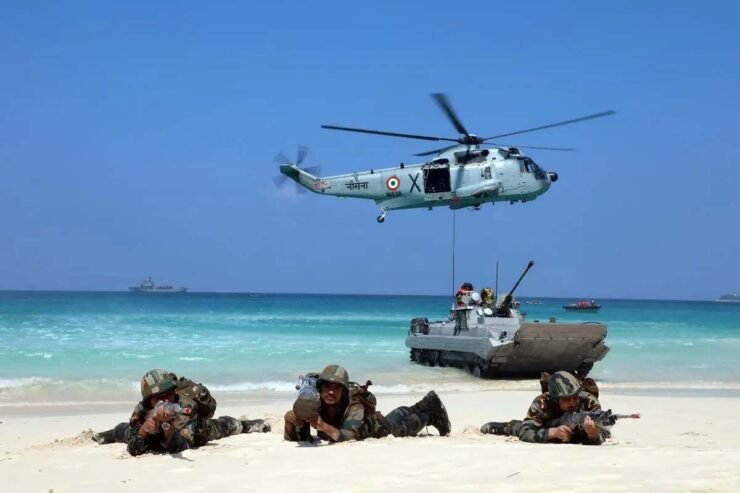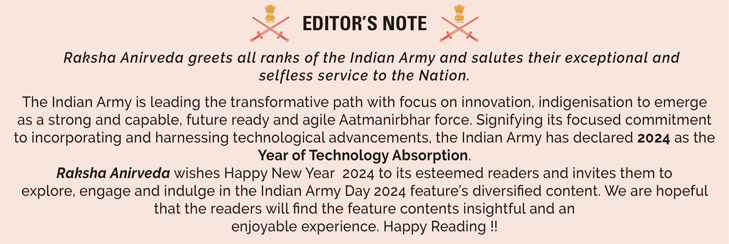
India remains apathetic towards national security. More than 75 years after Independence, we are without a national security strategy though the National Security Advisor (NSA) was tasked in 2019 to define one. Notwithstanding the denials, the absence of a strategic defence review with one single Division holding 800 km frontage in Eastern Ladakh led to repeated Chinese intrusions and an altered LAC in 2020 (https://www.telegraphindia.com/india/china-tents-in-occupied-depsang-plains/cid/1901228).
Government-appointed committees after the 1999 Kargil conflict highlighted serious shortcomings in our national security set up and military cohesiveness. Consequently, HQ Integrated Defence Staff (IDS) was established in 2004 but without a permanent head till recent times, making it largely ineffective. Also, the first CDS took charge in January 2020 (two decades after the Kargil conflict) not as ‘the voice’ of the military but with equal voting rights as the Service Chiefs – cunningly inserted in the relevant CCS note to enable bureaucratic arbitration.
The post of CDS was kept vacant for eight months before the second CDS was announced; elevating a veteran officer that indicated no serving three-star and above were fit for the post. Calls for theaterisation are not new. In 2005, HQ IDS ordered multiple studies for theaterisation of the 17 single-service commands of the Armed Forces, which were discussed threadbare with representatives of the three Service HQs in attendance. Former Army Chiefs Generals Ved Malik and S Padmanabhan also stressed on the need for Integrated Theatre Commands (ITCs) and Integrated Functional Commands (IFCs).
Most Indians don’t play football but the bureaucrats (some on foreign payroll or blackmail) love sowing dissent among the Services and kicking around national security like a football. One Service Chief just before retiring in 2007 said, “In principle I am all for integration across the board. In our context, however, until such time the threat of low-intensity conflict (LIC) and insurgencies subsides, it may be premature to either appoint a CDS or go in for integrated theatre commands” (http://www.indiandefencereview.com/news/theatre-commands-suffer-monkey-bite/). LIC and insurgencies having no relevance whatsoever to delay appointing a CDS and establishing ITCs, he was obviously speaking on behalf of the bureaucracy, who showed him the carrot.
The dismal performance of short-tenured Chinese and Russian soldiers in Galwan and Ukraine respectively is on display. Yet, our government has drastically reduced recruit training to mere four-months, followed by four-years of military service. Political skullduggery is noticeable with the defence minister saying the Agnipath scheme is not to save money, the media hollering this is all about money and politicians happy to publicise ‘skilling’ of many more Indians, even though it takes 7-8 years to skill a soldier in real terms. Next target are the fixed class regiments ignoring their outstanding history. How all this cripples the cutting edge of the forces, particularly the Army, is of no concern because the military will be blamed for whatever eventually happens.
The overemphasis on technology and non-contact war must also be viewed in context of the ongoing Ukraine conflict where soldiers on ground are indispensable. Even more relevant is the mountainous-high altitude terrain in which we would be fighting. The recent faceoff in Yangtse proves this beyond doubt. This re-emphasises the folly of short-tenured soldiers and the misplaced move of “downsizing” the army instead of “rightsizing” it.
The first CDS was tasked to operationalise the ITCs during his tenure. A PTI release of November 7, 2021 stated that India will likely firm up a roadmap for rolling out Theatre Commands by mid-2022 and likely operationalise these organisations over next 2-3 years (https://economictimes.indiatimes.com/news/defence/roadmap-for-ambitious-theaterisation-plan-likely-to-be-firmed-up-by-mid-2022/articleshow/87567752.cms?from=mdr). Our policy makers perhaps wanted military theaterisation completed in short time looking at the next general elections plus aping theaterisation of China’s PLA even though China took many years to complete the process.
The first CDS was in office for less than two years because of his death in a helicopter crash. Now the clamour for military theaterisation has been raised again with the new CDS in office. Military theaterisation is a complex issue requiring deep analysis. The issue of theatre Commanders reporting to a CDS who does not have full “operational powers” has been raised in the past but the government remains non-committal.
In 2017, Admiral Sunil Lanba, then Naval Chief and Chairman, Chiefs of Staff Committee told the media, “The three Services are not in agreement on theatre commands. The IAF is not in agreement. There’s a need for an operational commander to look after the theatres… We need one operational commander”. Later, the first CDS raised a controversy by publicly calling the IAF a “support arm”.
Presently we have the Andaman and Nicobar Command (ANC) and the Strategic Forces Command (SFC). Recent additions are the Defence Cyber Agency, Defence Space Agency and Armed Forces Special Operations Division. Media reports in September 2021 stated that work had commenced to establish four ITC; an integrated maritime command (MTC), Air Defence Command (ADC) and two-land based commands – one each for China and Pakistan. The report also said that these ITCs will take concrete shape in the next 2-3 years and quoted the CDS saying that resources will be reallocated from one theatre to another as and when a contingency is faced, as is the case even now (https://timesofindia.indiatimes.com/india/india-kicks-off-groundwork-for-four-integrated-theatre-commands/articleshow/86047288.cms). In addition would be the need for integrated Training Command (s) and Logistics Command (s). It is also unclear whether the ADC will control airspace above the MTC.
The ITC being planned for the China border would also be responsible for the Indo-Myanmar and Indo-Bangladesh borders. Presumably, this is on the lines of China’s Western Theatre Command which is responsible for Tibet’s borders with India, Bhutan, Nepal, Pakistan, Afghanistan, Kyrgyzstan, Kazakhstan and Tajikistan and Western Mongolia. But Beijing knows none of these countries would attack China, which is not the case with India. India faces a dual China-Pakistan threat and in future may also face a Chinese threat through Myanmar.

Our media remained silent but former Union Minister Subramanian Swamy tweeted that Chinese President Xi Jinping distributed maps showing Ladakh and Arunachal Pradesh as part of China and J&K as part of Pakistan at the SCO Summit in Uzbekistan during September 2022 which was also attended by Prime Minister Narendra Modi. Ladakh and NEFA (Arunachal Pradesh) were called two of the five fingers of Tibet by Mao Zedong. Therefore, China initiating conflict in these regions is certain. Moreover, present Northern Command would face a dual China-Pakistan threat to Ladakh and J&K, which would be coordinated by China. So, would it be prudent to divide Northern Command between two ITCs or give it a separate special status?
What assets the proposed Maritime Command would have is unclear but looking at the extent of our maritime borders, in all probability it would need considerable assets of the IAF in the event of operations. Presently, the Army has borrowed MQ-9 Predator drones from the Navy to monitor the PLA astride the LAC, which is not the first time assistance from the Navy has been taken. In the past the Army deployed the Navy’s P-8I maritime surveillance aircraft for similar tasks. Media reports say that India is to buy additional 15 x C-295 transport aircraft for maritime surveillance but that would take time.
Above must be viewed together with the statement of IAF Chief, Air Chief Marshal VR Chaudhari, who while stressing on the need to be prepared for prolonged wars on December 10, 2022, spoke of the depleting combat strength of the IAF due to phasing out of the MiG 21s which would be followed by the Jaguar and Mirage fighter jets. He mentioned that the “immediate gap is being filled by the Multirole Fighter Aircraft, 114 of which will be made in India with a foreign partner” but gave no timeframe (https://www.tribuneindia.com/news/nation/must-be-prepared-for-prolonged-wars-indian-air-force-chief-air-chief-marshal-vr-chaudhari-459691). This appears to be at the heart of IAF’s fear of distributing air assets command-wise especially when war is prolonged, is multi-front and involves the seas as well.
Ironically, holistic long-term planning remains a casualty. HQ 14 Corps was raised as a reaction to the massive Kargil intrusions. HQ South Western Command came up without reference to the IAF; IAF integration came much later. There was also a plan to raise North Western Command which was shelved. We are aping the PLA to have a single command for the China border but if we truly want military integration why don’t we learn from China’s Strategic Support Force which incorporates intelligence, technical reconnaissance, electronic warfare, cyber warfare and space warfare to support all ITCs together with the Rocket Force? Should we not seriously examine this model rather than nurturing separate entities?
Presently, information warfare is largely left to the Armed Forces, with no union ministry specifically tasked for it. Civil-military fusion is at its lowest – no matter the propaganda because the Armed Forces are being relegated to levels below police forces by the politico-bureaucratic construct. True integration of intelligence agencies with the Armed Forces Special Operations Division is lacking because of which there is no move whatsoever to employ them in areas of our strategic interests to shape the environment in India’s favour.
Theaterisation is a must to address new age warfare and achieve greater synergy in land, air, sea, space, cyber and the cognitive domains. The bureaucratic advice to the national apex would be that immediate military theaterisation would give huge political dividends to the ruling party but decisions made in haste would cause permanent damage to development of comprehensive national power; of which the military is an essential component. We maybe late in theaterisation but there is a need for pragmatism. Concurrent to deliberating the above issues it would be prudent to pinpoint the exact threats through a strategic defence review and defining a national security strategy.
The writer is veteran of the Indian Army. Views expressed are personal. The views expressed are personal and do not necessarily reflect the views of Raksha Anirveda











